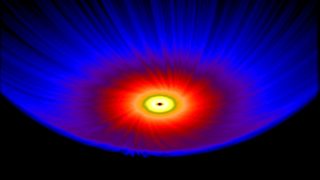HD61005 is a nice normal, young star with a dusty disk that will likely make planets one day. Real soon now in fact.
But HD61005, like some other stars, is different.
It is warped.
Well, the rim of its disk is.

Warped disk of HD61005 (click to embiggen)
The above picture is a Hubble image with the light from the central star suppressed, showing the extended disk of dust around the star.
As you can plainly see, the disk around the star is bent.
Question is why?
We've seen warped disks around stars, and often there is an apparent reason, such as radiation pressure from another, massive and hot star in the star forming association, or, possibly warping from gravitational interaction due to close encounters with other stars.
But, what about isolated young stars in sparse star forming regions or in the outskirts away from other stars?

Theory.
So much more elegant than the mess of reality, isn't it.
Debes, and collaborators, noticed the presence of interstellar clouds near a star with a warped disk, and conjectured that ram pressure stripping of the dust in the outer disk was responsible for the observed warps.
Next step was modeling, and sure enough, numerical simulations show the simulated disk morphology and scale match the observed systems.
It works.
Debes et al, ApJ 702, 318 (2009)
Very nice.
- Log in to post comments


Very nice indeed. Dare I suspect that others are now looking for similar conditions to see if there are similar stars/disks in the neighborhood?